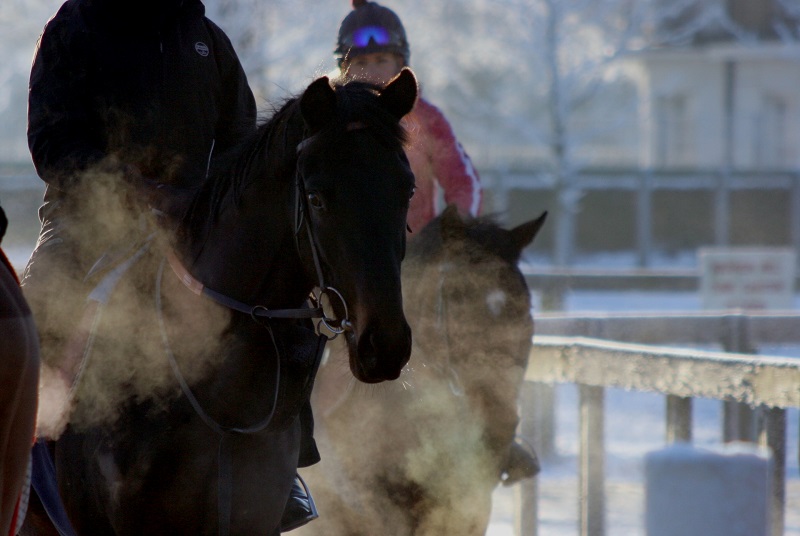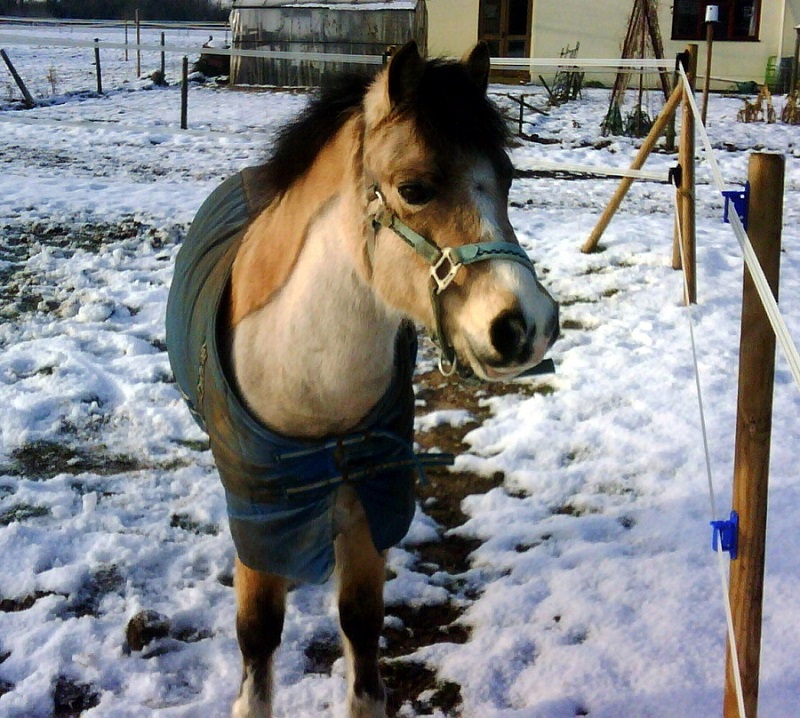Posted: 5th March 2018 | Back to news feed

Most horses in the UK may not be acclimatised to the low temperatures we are experiencing currently especially as a drop to -5°C or lower with wind chill has come on fairly suddenly. Here are some tips to help keep your horse healthy in this cold snap.

Colic
Cold weather often results in an increase in colic, especially impaction colics. This can be due to increased time in the box, failure to reduce hard feed and decreased water intake. You can try to encourage more drinking by soaking or steaming hay or adding warm water to feeds and adding some hot water to water buckets when you are at the stables to take the chill of it (15-20°C). It goes without saying to make sure its mixed so that hot water does not sit on the top and potentially put your horse off!!!
Drinking
Horses often drink less in cold weather. Buckets and troughs icing over can be a big problem. You can insulate troughs with bales of straw or bedding and cover the top ½ to a 1/3rd of the trough leaving an area for the horse to drink from. Take the chill off water in buckets when you are at stables but not too much as this can cause it to freeze quicker (The Mpema effect). A 250 or 500ml water bottle with 1-2 25ml scoops of salt (or electrolytes if you don’t have ordinary salt) and water placed in a bucket or trough can prevent it freezing over. But check this does not scare your horse from drinking!
Warming-Up
Not surprisingly it takes your horse longer to warm-up in cold weather. If muscles, ligaments and tendons (soft-tissues) are not adequately warmed-up before faster or harder work (e.g. jumping) then this can increase the risk of injury. This is easily managed though – either allow longer at walk and trot before moving into faster/harder work and or exercise with a quarter blanket to increase the speed at which the body warms up.
Orthopaedic Injury
A major risk factor for injury is exercising on uneven surfaces and surfaces that change suddenly over a short distance from soft to hard or vice versa. Surfaces (natural and synthetic) are most likely to be adversely affected by low temperatures early in the morning, especially areas that do not get early sunlight on them. These can stay frozen all day in cold spells. For horses with degenerative type conditions such as arthritis, hard and uneven ground can be “jarring” and combined with low temperatures can lead to increased stiffness and unsoundness.
Feet
Check your horses’ feet for any build-up of ice in the frog. This can make the horse unsteady and more likely to slip or fall and can increase loading on joints, tendons and ligaments. Grease or oil can help slow the build-up.
Respiratory Health & Exercise
Many people will be familiar with the fact that human asthma is worse in cold weather. Just before last Christmas Asthma UK estimated that 4 million people in the UK (around 75% of total asthmatics) would be at risk of life-threatening attacks due to breathing in cold air due to the sudden drop in temperatures. The advice given was to avoid exercise in the cold and to wear a scarf over the nose and mouth to help warm and humidify the inspired air. The effect of cold-air on human athletes is also well recognised, particularly in ice-hockey players and cross-country skiers, where it is referred to as “ski-asthma”.
Horses are also commonly affected by asthma (often referred to as IAD/RAO/equine COPD/heaves). This is predominantly related to breathing in allergens (moulds, pollen, dust, etc) which lead to an inflammatory reaction, production of mucus and narrowing of the airways. However cold air acts in a different way and leads to the same effects but without involvement of allergens through irritation of the nerves in the airways. We have previously demonstrated that damage occurs to the airways in “healthy” horses during a slow canter breathing air around 5°C as well as during galloping. In addition, a study from North America showed that the number of Standardbred racehorses with blood in the airways after exercise increased as the air temperature dropped.
Whilst scarves may work for people and whilst some cold weather masks have been tried for horses, these are not considered to be effective.
Stabling
Don’t be tempted to close up the ventilation. This is likely to increase the risk of respiratory problems.
Rugs
Horses lose heat in breath, faeces and urine, from the skin/coat surface, by contact with colder surfaces, such as the ground, by radiation to colder surfaces and by sweating. Older, younger, underweight, light type, sick and clipped horses and ponies are likely to need rugs in this weather even if its only a lightweight New Zealand. A horses Winter coat when dry and clean has been estimated to have a Tog rating of around 1-2. So if we consider that a Summer duvet has a Tog rating of 4.5 then this would already be increasing the insulation of the horse by a factor of 2-3 times. Some really thick rugs may well approach a Tog rating of 15 which would only likely be needed by sick newborn foals or very thin old horses in extremely cold weather! More horses are likely to need rugs this Winter because of the sudden drop in temperature and the lower than normal Winter temperatures.

How to decide when to rug….
-Don’t rug horses based on how cold you feel!
-Older horses, young horses, thin horses and clipped horses will need rugs first
-For most horses (unless clipped and living out 24/7) rugs should not be considered before temperatures overnight begin dipping towards 5-10°C.
-Horses without access to any form of shelter when outside may need rugs before those that have shelter
-Ideally start with lighter rugs and move to thicker rugs as it gets colder.
-After a month of cold weather your horse may be able to swap back to a thinner rug once its acclimatised
-Feeling your horses’ legs, face or ears is a poor indicator of how warm it is. Placing your hand under the rug behind the withers is a good spot. If it feels cold then you may want to consider a thicker rug. If it feels damp then you may want to consider removing the rug as its likely your horse is too warm.
-Horses without access to field shelters will need thicker rugs as the temperature drops.
-Remember that wind and cold and rain will induce the greatest heat loss.
Horses that Live Out
Make sure water troughs do not stay frozen. After you have smashed the ice remove it if possible. This will slow the freezing over. Placing straw bales around the trough helps insulate and slows freezing. You can also cover 2/3rds of the top of the trough leaving 1/3rd for the horses to drink from which will also slow freezing. Hot water in a thermos or bucket can give temporary relief from ice. You might consider taking fresh water and putting out buckets when you visit if the troughs are impossible to keep clear. Horses on haylage or steamed hay have an advantage as they are higher moisture and result in less need to drink. Make sure horses living out always have forage! They need this to generate heat. Check rugs for rubbing.
Energy & Feed
During cold-weather horses use more energy to keep warm, particularly as air temperatures remain close to freezing. However, for a period of a week it would not be necessary or even desirable to increase a horses feed intake provided they have free access to moderate to high quality forage. Cold-weather exercise also increases the amount of glycogen that is used as an energy source as adrenaline levels are higher in cold weather and adrenaline increases glycogen use. This could mean a slight decrease in performance or a slightly decreased capacity for exercise but this would not be noticeable for the majority of horses. The biggest risk for energy intake causing problems for horses during cold spells is when horses cannot be exercised as normal but feed intake is maintained. For horses that are on overweight, laminitic prone or prone to tying-up, this can push them over the edge. Therefore, if you have to decrease work due to cold weather then also cut the hard feed back as well.
TOP TIPS FOR COLD WEATHER TRAINING & MANAGEMENT
* Take the chill off water in buckets when you are at stables but not too much as this can cause it to freeze quicker (The Mpema effect).
*A 250 or 500ml water bottle with 1-2 25ml scoops of salt (or electrolytes if you don’t have ordinary salt) and water in placed in a bucket or trough can prevent it freezing over. But check this does not scare your horse from drinking!
* Wet feeds and forage to increase fluid intake and reduce the risk of impaction colic
* Check feet for ice and snow build up in the frog
* Make sure your horses have plenty of ad lib forage
* Keep stables well ventilated to avoid respiratory problems
* More horses are likely to need rugs this Winter because of the sudden drop in temperature and the lower than normal Winter temperatures.
* If you want to know if your horse is comfortable then consider something like the Orscana sensor and app
* Put your horses bit in your pockets or in warm water to warm it up before putting it in your horses mouth
* Spend more time at walk and trot when warming up
* Avoid moderate to hard exercise early in the morning or on very cold days, especially for horses with a tendency to respiratory disease
* Avoid hard uneven ground, such as in areas of an arena or track that do not get sunlight in the morning as these can stay hard and be a major risk for injury
* If you have to reduce daily exercise due to frozen or hard surfaces, then cut-back any hard feed, especially for laminitis and or tying-up prone horses
* This applies to all horses in work, not just racehorses or high-performance sport horses
The Equestrian Index newsfeed is compiled from articles submitted by advertising members and expresses the opinions of those members. Watsons Directories Ltd shall not be held liable for any inaccuracies or mis-statements therein.